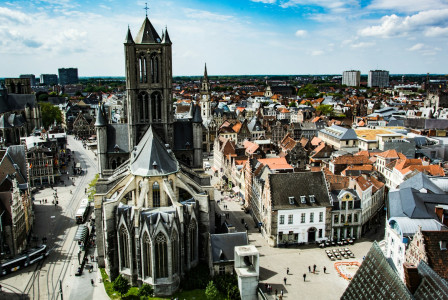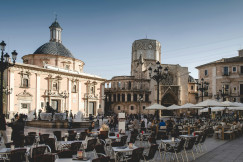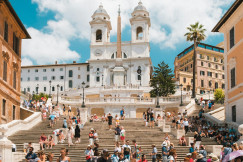Articles
08 August 2025
Ghent: Quiet Streets, Vibrant Tourism
Articles
08 August 2025
Adventure tourism
Coastal, maritime and inland water tourism
Cultural tourism
+65 more
Login / create an account to be able to react
-
83

Ghent has transformed its historic centre through a 2017 circulation plan that redirected car traffic, prioritised walking, cycling, and public transport, and expanded sustainable infrastructure. The shift, achieved in just one weekend, reduced through-traffic, accelerated cycling growth to 35 %, and improved accessibility for both residents and visitors. Integrated into the city’s wider mobility and climate goals, the approach has made Ghent more liveable while offering a practical model for other destinations seeking to balance tourism with sustainability.
Topics
Belgium
Academic / Research and VET Institutions
Business Support Organisation
Company with 250 or more employees
Cluster Organisations
Consumer Organisations
Cultural and Heritage Organisations
Destination Management & Marketing Organisations
EU Institutions
Financial Institutions and Investors
Industry Associations and Chambers of Commerce
International Organisations
Local Authorities
Media / Journalist Organisations
National authorities
Networks and Federations / Confederations
NGOs / Non-profits
Notified Bodies
Regional Authorities
SMEs (a company with less than 250 employees)
Social Economy Entity
Trade Unions
Other
-
Specific types of tourism
-
-
Adventure tourism
-
Coastal, maritime and inland water tourism
-
Cultural tourism
-
Ecotourism
-
Education tourism
-
Festival tourism
-
Gastronomy tourism
-
Health and medical tourism
-
MICE tourism
-
Mountain tourism
-
Religious tourism
-
Rural tourism
-
Sports tourism
-
Urban/city tourism
-
Wellness tourism
-
-
Transition Pathway Strategic Areas
-
-
Accessible tourism services
-
Best practices, peer learning and networking
-
Changes in tourism demand and opportunities
-
Circularity of tourism services
-
Coordinated information on travelling
-
Cross-border travelling
-
Digitalisation of tourism SMEs and destinations
-
Equal and fair tourism jobs
-
Funding and support measures
-
Governance of tourism destinations
-
Green Transition of Tourism Companies and SMEs
-
Improving formal education
-
Improving statistics and indicators
-
Innovative tourism services
-
Multimodal travelling
-
Online visibility of tourism offer
-
Pact for skills
-
Promoting PEF/OEF methods for tourism
-
R&I on climate-friendly tourism
-
R&I on digital tools for tourism
-
Short-term rentals
-
Skills needs for twin transition
-
Sustainable mobility
-
Tools for data on tourism
-
Tourism strategies
-
Training opportunities
-
Well-being of residents
-
-
Business activities
-
-
Activities of amusement parks and theme parks
-
Activities of associations and other organisations supporting tourism
-
Air passenger transport
-
Camping grounds, recreational vehicle parks and trailer parks
-
Events catering and other food services
-
Festivals, cultural and entertainment activities
-
Gardens and nature reserves activities
-
Holiday Housing / Apartments and other short stay accommodation
-
Hotel and similar accommodation
-
Mobile beverage services
-
Mobile food services
-
Museums
-
Operation of historical sites
-
Other
-
Other accommodation
-
Other amusement and recreation activities
-
Other food and beverage services
-
Other holiday reservation services
-
Other tourism transportation activities
-
Rail Passenger transport
-
Recreational and sport activities
-
Restaurants, cafes and bars (Food and Beverage serving activities)
-
Road passenger transport
-
Tour operator activities
-
Travel agency activities
-
Water (sea, coastal and inland) passenger transport
-
Share
Transforming mobility through strategic planning
In 2017, Ghent introduced a bold circulation plan to address the fact that nearly 40 % of motorised traffic in the city centre consisted of through traffic. Designed to reclaim public space for residents and visitors, the city was divided into six zones where car travel became impossible without detouring via the R40 ring road. This shift was implemented in just one weekend, when traffic patterns on about 80 streets were reconfigured, 2,500 road signs were updated, and 14 locations were closed off to most motorised traffic.
Cycling accelerated ahead of target
Following the changes, Ghent achieved a cycling modal share of approximately 35 %, a goal originally set for 2030 but reached ahead of schedule. The city has also enhanced its cycling infrastructure significantly, expanding it to about 506 km of cycle paths, including 181 km added since 2010, along with 17.1 km of bicycle streets and 63 bicycle bridges or underpasses.
Supporting infrastructure for a new visitor experience
By restructuring urban mobility, Ghent has created a city centre where pedestrians and cyclists enjoy greater access and safety. While explicit tourism-specific metrics are not available, this mobility model allows residents and tourists alike to move through the historic core with less congestion and more ease - especially beneficial during events like the Gentse Feesten, which draws 1-1.5 million visitors annually.
Managing visitor flows sustainably
Rather than treating tourism as a standalone sector, Ghent embeds visitor management into its broader urban strategy. The circulation plan aligns with the city’s Sustainable Urban Mobility Plan (SUMP), adopted in December 2023, which targets a 50 % shift to sustainable transport by 2030 through the expansion of multimodal hubs, electrification of public transport, and enhanced cycling infrastructure across the region’s 23 municipalities.
A replicable model of urban balance
Ghent’s approach demonstrates that transforming transport systems can enhance both liveability and visitor experience. By redirecting through traffic, prioritising cyclists and pedestrians, and bolstering infrastructure, Ghent has fostered a more inclusive, sustainable and navigable environment - suggesting a practical model for other European destinations facing similar mobility and tourism challenges
Comments (0)
Related content
See also
When Too Much Becomes Harmful: Rethinking Unbalanced Tourism in Europe
- Categories
- Coastal, maritime and inland water tourism Cultural tourism Ecotourism +64 more
Unbalanced Tourism Growth in Europe: Understanding Pressures, Impacts and Sustainable Pathways
- Categories
- Coastal, maritime and inland water tourism Cultural tourism Ecotourism +64 more
2022 - Country Reports
- Categories
- Coastal, maritime and inland water tourism Cultural tourism Ecotourism +64 more





